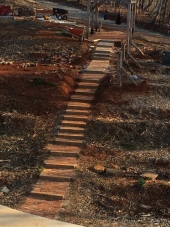



Casie Becker wrote:I have them at the most 24 inches away from the trunk. I made sure the roots of the trees and the shrub were intermingled so that when I cut back the indigo each year the nitrogen from the root die back is right at the tree roots. I think with anything but espalier I would be shading out the indigo with this close spacing. If you look very closely you'll see what looks like a group of sticks stuck into the ground, that's the dormant false indigo bushes after they've been cut back. They're one of the last things to come out of dormancy in my gardens. I may change my pruning time to late spring if I don't see any flowers this year. I think I should actually be pruning right after spring bloom. I think I've been pruning off the developing flowers, good for the plant to establish itself without wasting extra energy on producing seed, but I want flowers now.
There are a total of four peach trees arranged in a Belgian fence, with two and a half feet between each tree. They've been selected to produce the peaches over the course what I hope will eventually be at least three months. That one tree being so many weeks ahead of the others is a good start.

Casie Becker wrote:I grow mine next to espalier, which have very different requirements on things like spacing and light needs. But I will say that as a plant it has a very upright growth habit. Lower plants can grow very close to the base without being shaded out in my climate. I the whole plant down to about 12 inches after it goes dormant in the fall and it's come back well, so far.
I somewhat accidentally discovered this year how very well lupins work as nitrogen fixers. I was working on a stand of bluebonnets in my front yard. After their strong showing last year, the grass grew so thickly over that corner that hardly any managed to sprout this year. We're actually going to have to actively try to discourage the grass next fall to get the flowers back. Our bluebonnets are annuals lupins, but there are also a lot of perennial varieties. I think you'd have more success with them in Virginia than we do here. They're spring bloomers, too; so the timing might be right to draw pollinators to your fruit trees.




paul wheaton wrote:Suppose 20,000 people hear about this place and think they might want to come here.
Suppose all 20,000 start to listen to the first podcast.
I suspect that half will stop after a minute or two.
Half of that will stop a bit further in.
Half of that will make it to the end of the first podcast.
Half of those will choose to go on to the next podcast.
I am now down to 1250 people.
Let's suppose that 100 people make it to the end of the 10th podcast and are still thinking of coming here.
Let's suppose that 20 make it to the end of 100 podcasts and are still thinking of coming here.
Let's suppose that 10 people actually make the attempt.
Of those 10, some people realize that this is not the kind of thing they want to do. Some realize that they don't like me. It turns out that there are some that I don't like. Others it seems like everything is great, but after a few months or years .... not so much.
In the end, there might be one person. Maybe.
Conclusion: It isn't that I need to be somebody that charms ANYBODY/EVERYBODY. I need to be myself and find that 1 person in 20,000 that is a fit. And if I wish to build a community of more than me and one other person, maybe I need to get my stuff into more brains than 20,000 people.
Corollary: When people tell me what I have to do, have to say, have to think .... maybe I should direct them to this thread.

paul wheaton wrote:

elle sagenev wrote:So can you trench to get the pooled water moving? Or perhaps dig to make a full on irrigation pond?
If you need to stabilize the slope I'd use something other than your food trees. I saw someone use St. Johns wort and it was so beautiful, and you could harvest some for medicinal use if needed. So you can think outside of the tree box when it comes to soil stabilization. Bushes, non-food trees, etc. Go that route.
